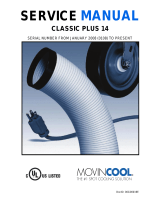
Mechanical Operation
General:
The machine makes, stores and dispenses ice. It
also dispenses water. The ice making portion of
the machine produces flaked ice at about 32
o
F.
The ice falls thru a chute into the dispensing bin.
Above the cylindrical bin is a dispense drive motor
and electric eyes. The drive motor is connected to
an ice vane in the bin. When the user holds a
container in front of the glass sensor and below the
ice chute, the dispense drive motor rotates the
vane and the ice. There is a slot in the base of the
bin, located just above the vend spout and glass
filler lever. When the ice moves over that slot,
some of the ice on the bottom of the bin falls thru
the slot, into the chute and fills the container.
ON/OFF Control:
Flaked ice is produced by the ice maker until ice
builds up between the electric eyes. When the
electric eyes can no longer “see” each other, they
send a signal to the control board to shut the
machine off. The refrigeration compressor stops
but the auger drive motor will continue to operate
for about 2 minutes to clear the evaporator of ice.
Water Control:
Because water is such an important requirement
for making ice, a water level sensor has been
placed in the reservoir. If the water supply to the
machine should fail, the water level sensor will
send a signal to the control board to shut down
the machine.
Refrigeration:
The refrigeration system uses a hermetic
compressor (specifically designed for R-134a),
forced draft air cooled condenser, capillary tube
and vertical flaked ice evaporator. Inside the
evaporator is a slowly rotating auger. The auger is
supported by bearings at each end, and there is a
face-type water seal above the bottom bearing.
The auger is driven by a 1/10 HP direct drive gear
reducer. The auger drive motor has a speed
operated switch on it that will keep the compressor
from operating if the auger motor is not turning at
full speed.
Water System
Water flows from the building supply to the
reservoir and to the electric solenoid valve. Water
from the reservoir is used to make ice. Water the
flows thru the solenoid is dispensed.
The bin, sink and reservoir overflow all have
drains.
Ice Vending
Dispensing takes place when the touch free
sensor’s infrared beam bounces back to the
sensor from a container placed directly in front of
the sensor and under the ice chute.
When the beam is reflected back, it signals the
circuit board to connect power to the dispense
drive motor, and ice is then moved over the slot in
the base of the bin, where it falls by gravity thru the
chute into the container.
If the Water switch is On, water is also dispensed
at the same time.
Dispensing continues until the beam is no longer
reflected back to the sensor.
MDT3F & MDT4F
April 2010
Page 12
Touch Free Sensor




















